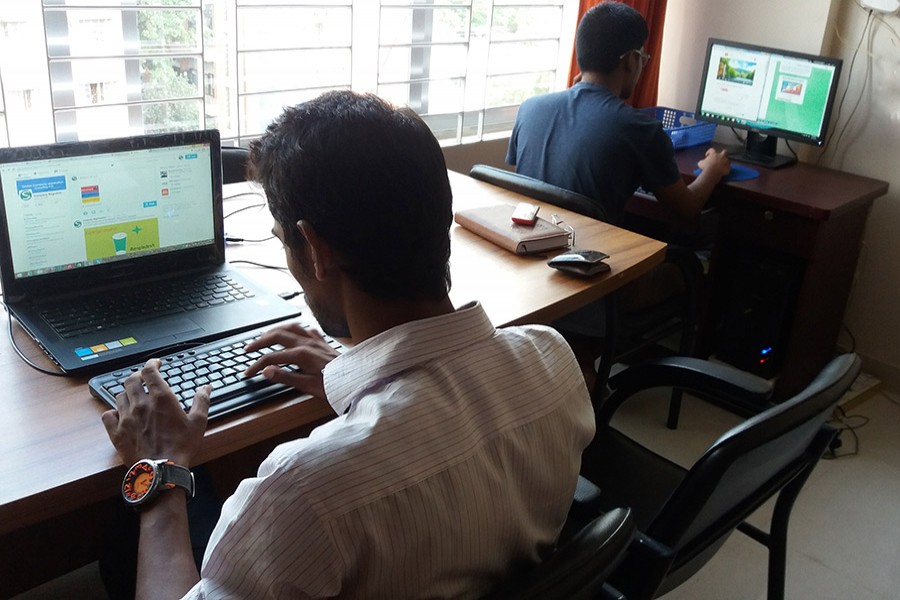An official ratings agency says the Bangladesh economy can boast of fostering a 'job-rich growth', with the jobless rate remaining static at only 4.2 per cent last fiscal.
Bangladesh Bureau of Statistics (BBS) came up with such economic branding of the country on the basis of the latest Labour Force Survey (LFS) that found the unemployment rate in the previous financial year (FY), 2015-16, also at 4.2 per cent.
The national statistical body unveiled the findings Tuesday in Dhaka, which showed that the total number of unemployed people in 2016-17 was 2.7 million.
In the FY2016, Bangladesh's total jobless was 2.6 million, the survey said.
According to the LFS 2016-17 of the BBS, 4.9 per cent of rural population are still jobless among the unemployed while the rate in the rural areas was lower at 4.0 per cent.
The report showed that a total of 0.9 million persons in urban areas and 1.8 million in rural areas were unemployed.
Out of the 4.2 per cent jobless, some 3.1 per cent are males and 6.7 per cent are females.
The latest LFS shows that the employment growth in the country was 2.3 per cent wherein female's participation expanded at an impressive level of 4.6 per cent.
However, the employment growth for the males expanded by 1.0 per cent, year on year, in FY2017, the BBS count showed.
According to the survey, some 1.3 million fresh jobs were created over the year while another 1.4 million people shifted to paid works from their unpaid jobs in the previous period.
The bureaus says since some 3.7 million jobs including 1.0 million overseas ones were created in the last FY2017, the country's economic growth could be branded as "job-rich growth".
BBS in its survey showed the job-growth rates in the industrial and agricultural sectors dropped while that in the service sector increased in a shifting economic paradigm.
According to the survey findings, employments in the service sector had been expanded by 7.8 per cent.
However, the employment rate in the industrial sector dropped by 0.48 per cent in the last FY2017 compared to the previous survey period of FY2016 and in the agriculture sector fell by 4.9 per cent.
The LFS showed an estimated 60.8 million of the population aged 15 or older employed.
By occupation, skilled agriculture workers accounted for the largest share of the total employed population, at 32.4 per cent.
The largest proportion of the employed population was engaged in agriculture, at 40.6 per cent, followed by 14.4 per cent in manufacturing, and 14.2 per cent in wholesale and retail trade.
By main industrial sector, agriculture employed 40.6 per cent of the employed persons, followed by service, at 39.0 per cent, with the smallest proportion in the industry sector, at 20.4 per cent.
The BBS showed that one-third (31.9 per cent) of the employed population had not had any formal education. More than 15.7 million employed workers (25.8 per cent) had completed some or primary education, while more than
18.7 million (30.8 per cent) had completed secondary education.
The findings also show with no level of education, a large number of employed persons is in the informal employment at 94.4 per cent and only at 5.6 per cent in the formal employment. By age group, 89.2 per cent of the youths aged 15-29 engaged in the informal employment, and it is 83.0 per cent of the adults aged 30-64 in the informal employment.
The survey on labour force collected information on various aspects of people's economic activity and provided labour-market statistics relating to employment, unemployment and underemployment and many other aspects of people's working lives at the national and divisional levels with urban and rural breakdown.
In rural areas, 88 per cent of the employed are in informal sector employment whereas it was 77.3 per cent in urban areas. In rural areas, 93.3 per cent of the females are in informal sector employment whereas it was 87.4 per cent in urban areas. At the national level, only 8.2 per cent females engaged in formal employment and it was 17.9 per cent for the male counterparts.
More than 20.1 million youths aged 15-29 participated in the labour force, with a number of males (13.1 million) and females (7.0 million) among them. Their proportion within the total labour force represented 31.6 per cent.
The youth labour-force proportion was higher in urban areas, at 34.5 per cent, than in the rural areas, at 30.5 per cent.
An estimated 17.9 million of them (29.5 per cent of total employed) were employed, with large difference in numbers between male youth (at 12.0 million) and female youth (at 5.9 million).
Meanwhile, the BBS survey said the largest share of the employed population (44.3 per cent) worked as own-account workers, followed by (39.1 per cent) as employees and contributing family workers (11.5 per cent).
The survey findings show that of the estimated 24.2 million paid employees, 56.7 per cent were paid on monthly basis, 34.5 per cent on daily basis, 7.3 per cent on weekly basis and only 1.5 per cent on some other bases.
The reported average monthly earnings of paid employees were Taka 13,258.
Planning Minister AHM Mustafa Kamal, State Minister for Finance and Planning MA Mannan, Member of the General Economics Division, Secretary-In-Charge of the Statistics and Information Division Surendra Nath Chakrabharty, Director-General of the BBS Amir Hossain were present at the LFS findings dissemination function at the BBS headquarters.


